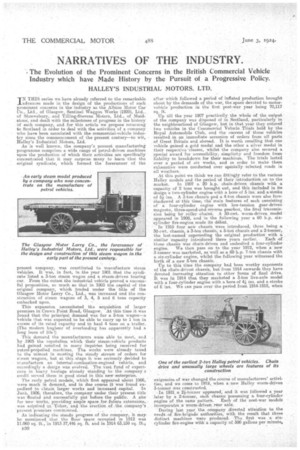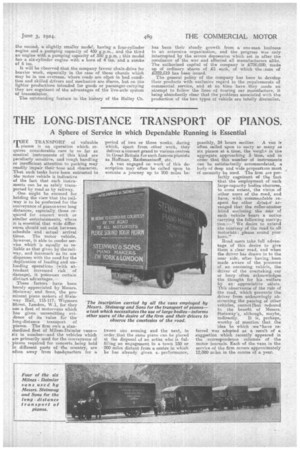NARRATIVES OF THE INDUSTRY.
Page 14

Page 15

If you've noticed an error in this article please click here to report it so we can fix it.
. The Evolution of the Prominent Concerns in the British Commercial Vehicle Industry which have Made History by the Pursuit of a Progressive Policy.
HALLEY'S INDUSTRIAL MOTORS, LTD.
IN THIS series we have already referred to the remarkable advances made in the design of the productions of such prominent concerns in the industry as the Albion Motor Car Co., Ltd., of Glasgow, Sentinel Waggon Weeks (1920), Ltd.. of Shrewsbury, and Tilling-Stevens Motors, Ltd., of Maidstone', each dealt with the milestones of progress in the history Of each company, and for this article we propose returning to Scotland in order to deal with the activities of a company who have been associated with the commercial-vehicle industry since the commencement of the present century—to wit, Halley's Industrial Motel's, Ltd.
i As s well known, the company's present manufacturing programme comprises a wide range of petrol-driven machines upon the production of which their activities are specifically concentrated that it may surprise many to learn that the original syndicate, which formed the forerunner of the
present company, was constituted to manufacture skein veldeles. It was, in fact, in the year 1901. that the syndicate listed a 3-ton steam wagon and a steam-driven touring car. From the outset the industrial vehicle proved a succe.ss-fui proposition, so mach so that. in 1903 the ea,pital of the original company, which traded under the title of the Glasgow Motor Dirry Co., Ltd., was increased and the construction of steam wagons of 3, 4, 5 and 6 tons capacity embarked upon.
This expansion necessitated the acquisition of larger premises in Crown Point Road, Gla.sgow. At this time it was found that the principal demand was for a 5-ton wagon—a Vehicle that was expected to be able to carry up to 1 ton in excess of its rated capacity and to haul 4 tons on a trailer. (The modern bugbeer of overloading has apparently had a long lease of life !)
This demand the manufacturers were able to meet, and by .1905 the reputation which their steam-vehicle products had gained resUlted in many inquiries being received for petrol-propelled machines; The works were already taxed to the utmost in meeting the steady stream of orders for seam wagons, but at. this stage it was seriously decided to ilianufa,cture an internal-combustion-engined vehicle, and accordingly a. design was evolved. The vast fend of experience in heavy haulage already standing to the company s credit served them in good stead in this new enterprise.
The early petrol models, which first appeared about 1906, i
were much n demand, and in due course it was found ex pedient to detain larger works and increased capital. In June, 1906, therefore, the company under their present title was floated and successfully pet before the public. A site for new Works, providing ample space for .future extensions, was ac4uired 'at -Yolter, and • the erection of the company's present premises commenced.
As indicating the steady progress of the company, it, maybe mentioned that the iloor space occupied in 1912 was 11,060 sq.. ft.,-in 1913 37,446 sq. ft. and in 1914 63,159 sq. ft.,
1130 after which followed a period of inflated production brought about by the demands of the war, the apace devoted to motorvehicle production in the first post-war year being 70,117 sq. ft. Hp till the year 1907 practically the whole of the output of the company was disposed of in Scotland, particularly in the neighbourhood of Glasgow, lad, in that year they entered two vehicles in the Commercial Vehicle Trials held by the Royal Automobile Club, and the anccess of these vehicles resulted in an immediate accession of orders from all parts of Great Britain cud abroad. It is worth recalling that one vehicle gained a gold medal and the other a silver medal in their respective 'classes, whilst the company also secured a special award for accessibility, simplicity and freedom from liability to breakdown for their machines. The trials lasted over a period of six weeks, and in order to make them exhaustive Were conducted over specially selected roads in all weathers.
At this point we think we can fittingly refer to the. various Halley models and the period of their introduction on tothe
market. In 1907 a 20 h.p. chain-driven chassis with a capacity of 2 tons was brought out, and this included in its design a two-cylinder engine with a bore of 5 ins, and a stroke of 5-1 ins.. A 3-ton chassis tind a 4-ton chassis ware also foreShadowed atthis time; the main features of each consisting of a four-cylinder engine with low-tension gear-driven magneto, three-speed-and-reverse gearbox, the final transmission being by roller chains. A 30-cart. worm-driven model appeared in 1908, and in the following year a 60 h.p. sixcylinder fire-engine made its debut. In 1910 faux new chassis were introduced, these, being a 30-cwt. chassis, a 3-ton chassis, a 5-ton chassis and a 2-tanner, the last-named superseding the original productionwith a
siniilar 'capacity introduced three years earlier. Each of these chassis was Chain-driven and embodied a four-cylinder engine. We then pass on to the year 1912, when a new 3-toriner was marketed, as well as a 60 h.p. 7-ton chassis with a six-cylinder engine, whilst the following year witnessed the birth of a new 5-ton chassis, Up to this time the company had been worthy exponents of the chain-driveri chassis, but from 1914 onwards they have devoted increasing attention to other forms of final drive. It Was in 1914 that they marketed a 3-ton live-axle model with a four-cylinder engine with a bore of 44 Ms. and a stroke of 6 ins. We can pass over the period from 1914-1918, when
'exigencies of warachanged the course of manufacturers' activities,' and we come. to 1919,. when a new Halley worm-driven 3-tonner was constructed.
In 1921 a 24-tonner appealed, and it was followed a year _later by a 2-tormer, Oath' chassis possessing a four-cylinder engine of the same pattern. Each of the post-war models incorporates a worm:driven rear axle. During last year the company .directed attention to the needs-of fire-brigade authorities, with the result that three distinct machines were produced. Tim first was a sixcylinder fire-engine with a capacity of 500 gallons per minute,
the second, a slightly smaller model having a four-cylinder engine and a pumping capacity of 4&) g.p.m., and the third an engine with a pumping capacity of 350 gy.m.; this model has a six-cylinder engine with a bore of 4 ins, and a stroke of 6 ins.
It will be cbserved that the company favour chain-drive for heavier work, especially in the case of those chassis which may be in use overseas, where roads are often in bad condition and skilled drivers and mechanics are game, but on the lighter productions intended for goods or passenger-carrying they are cognizant of the advantages of the live-axle system of transmission.
The outstanding feature in the history of the Halley Co. has been their steady growth from a one-man business to an extensive organization, and the progress was only interrupted by the severe depression which set in after the conclusion of the war and affected all manufacturers alike. The authorized capital of the company is £750,000, made up of ordinary shares of 21 each, of which the (sum of £322,519 has been issued.
The general policy of the company has been to develop their products with exclusive regard to the requirements of commercial service, and at no time have they made an attempt to follow the lineas of -touring oar manufacture, it. being abundantly clear that the problems associated with the production of the two types of vehicle are totally dissimilar.






























